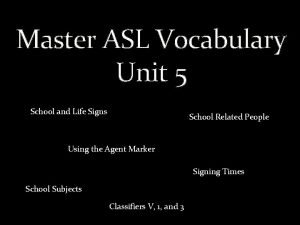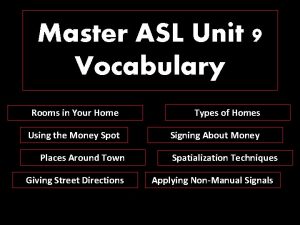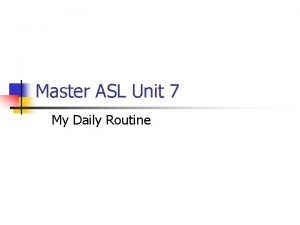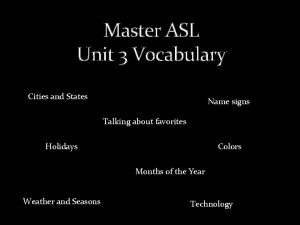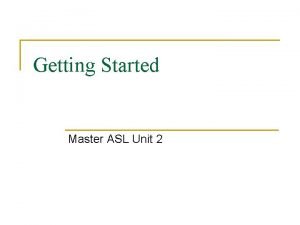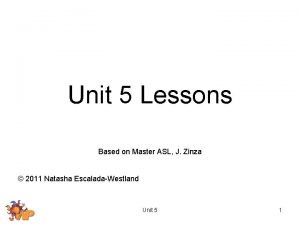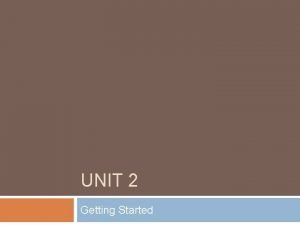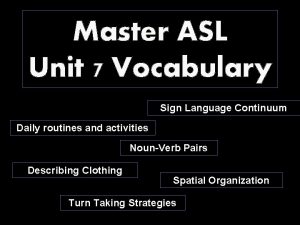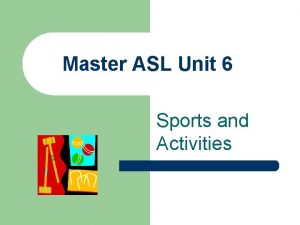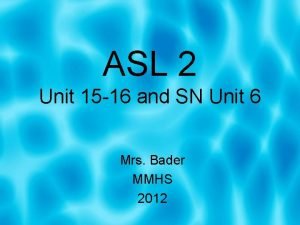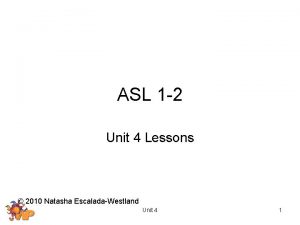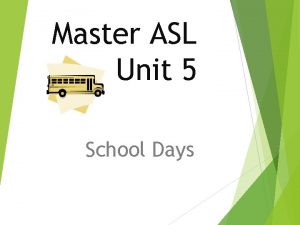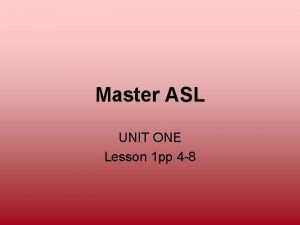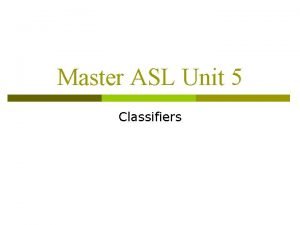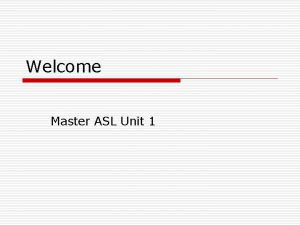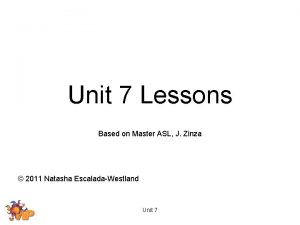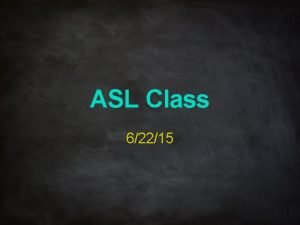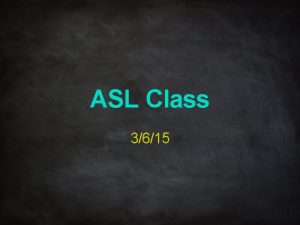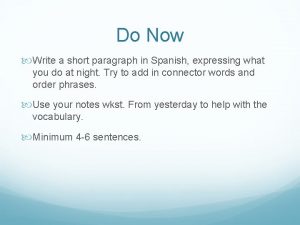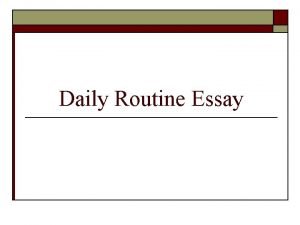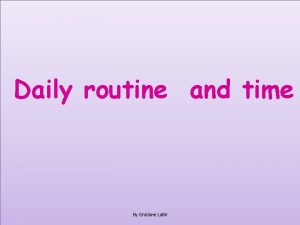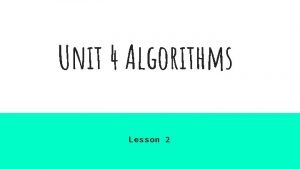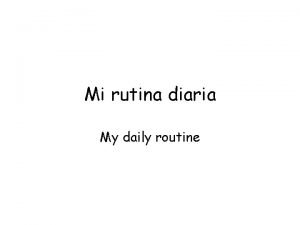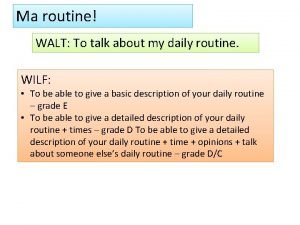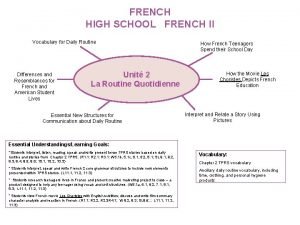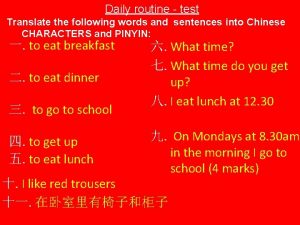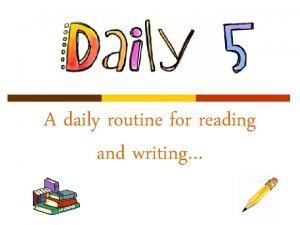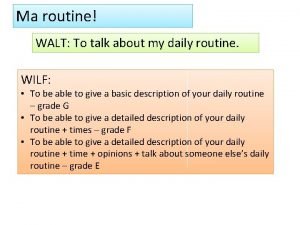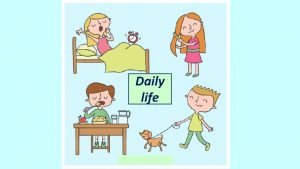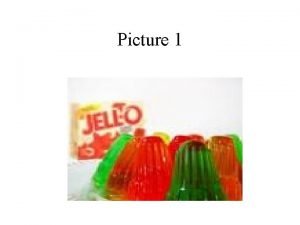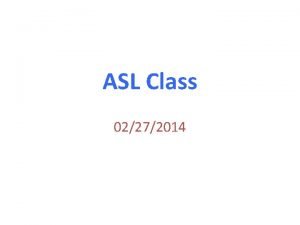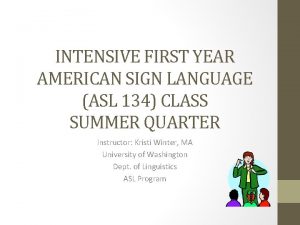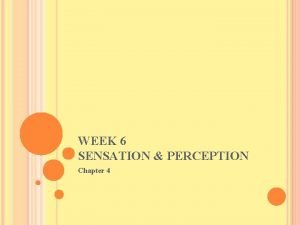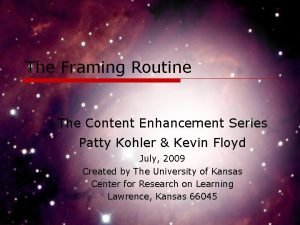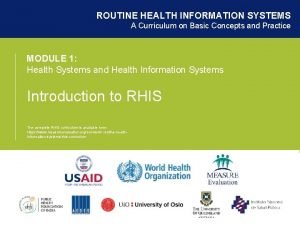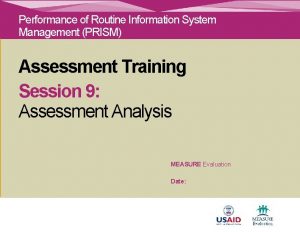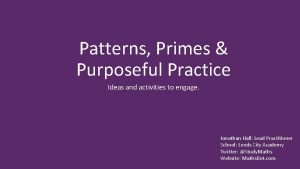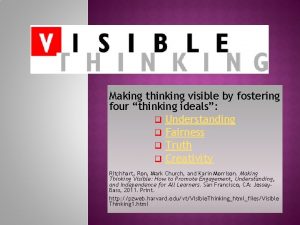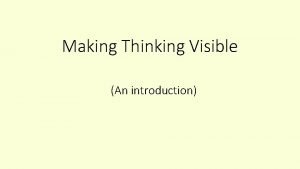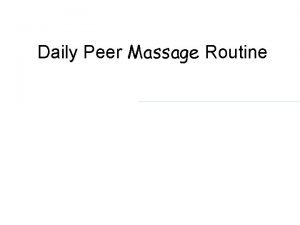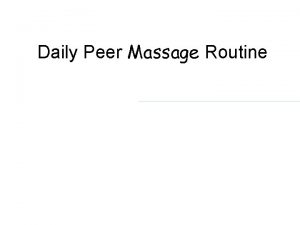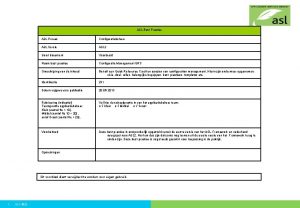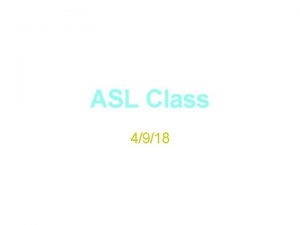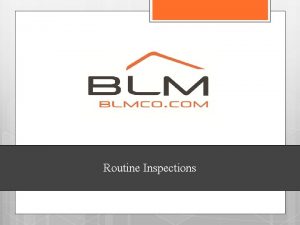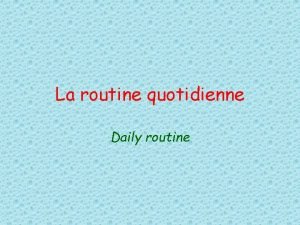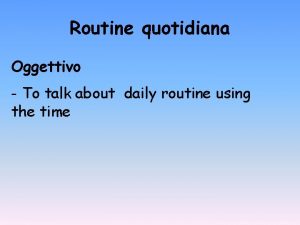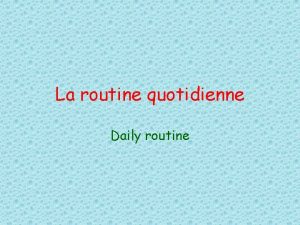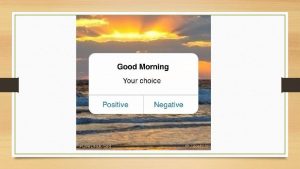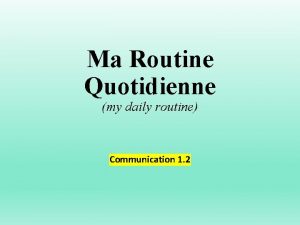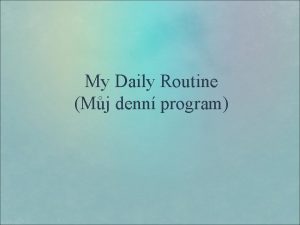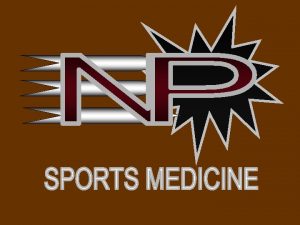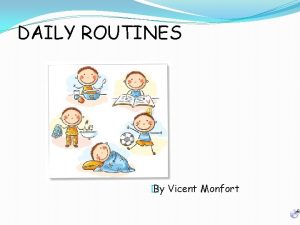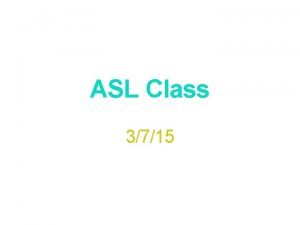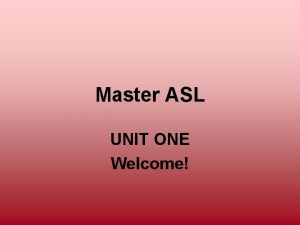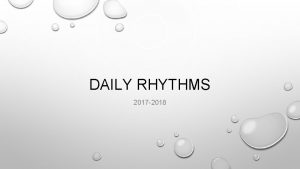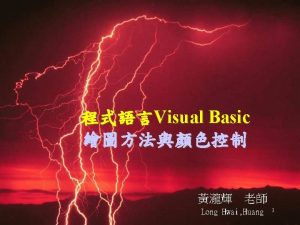Master ASL Unit 7 My Daily Routine Picture















































- Slides: 47

Master ASL Unit 7 My Daily Routine

Picture it… n n n Find a partner Pick up your handouts Put your name on your paper… upper left corner You know what to do… When finished make corrections in red and staple papers together and submit

Objectives n n n To sign about daily routines and activities To identify and understand noun-verb pairs To describe clothing To learn and use spatial organization To apply turn-taking strategies in conversations To understand the sign language continuum

Vocabulary—NO VOICE n n n EVERY EVERY AFTERNOON MORNING NIGHT WEEK YEAR

Where are you going? n n Watch the video dialogue. Sign the dialogue with your partner twice, once as Kelly and once as Sean. n Kelly: Where are you two going? n Sean: Every afternoon we have karate practice. What do you do? n Kelly: Oh, cool. I work every day and work out in the evenings. n Sean: Oh, ok. Yikes! Look at the time. We need to take off!

Analyze the Dialogue: Which ASL pronouns are used? n Which recurring days are mentioned? n What non-manual signal is interpreted as “YIKES!”? n

Practice Sentences n Sign the sentences below with your partner. n Sean works every afternoon. n Sundays Sean goes to church. n Saturday nights Sean goes to the movies with friends. n Sunday nights Sean studies for school. n Tuesday and Wednesday afternoons Sean plays basketball. n Thursday nights Sean plays games with his family.

Every Days n Every signs are part of the when group of signs so they come first in sentences. See EYES on ASL #5 to review when signs. Every signs can be interpreted as “every” or as “on” interchangeably, but don’t use the sign DURING with them. Every signs are made using the hand shape for the day of the week and moving it down as if through each week on a calendar.

Sign… n n n What time do you wake up every day? What time do you eat breakfast in the morning? When do you go to ASL class? When do you work? What time do you get ready in the mornings? What time do you want to get up every day?

Vocabulary—NO VOICE n n n n TAKE A BATH EAT BREAKFAST BRUSH HAIR BRUSH TEETH COMB HAIR GET DRESSED GET READY (2) n n n GET UP PUT ON MAKEUP OVERSLEEP SHAVE (2) SHOWER WAKE UP

Sentences n Sign: n n n I wake up around 7: 30. I get up between 8: 00 and 8: 15. On Saturdays I get up around 10: 00. My alarm rings around 6: 45. On the weekends I get up between 11: 00 and 12: 00. n Add and sign: n n n Every day, people should … Every morning, I … Every afternoon I’m late because I … I _____ every night. People _____ every day.

Vocabulary—NO VOICE n n n n n CHANGE CLOTHES DO CHORES, DUTIES EAT DINNER EARLY FALL ASLEEP GO TO BED EAT LUNCH REST, RELAX SET A CLOCK/ALARM

Sign… Ask your partner what time s/he does the following: • • • What time do you go to bed? When do you eat lunch? What time do you set your clock for? Do you do chores every day? When? What time do you tend to fall asleep? What time do you cook dinner?

Spatial Organization n In English the word THEN is often used to show a series of events. In ASL we use spatial organization. This groups related THOUGHTS, ACTIONS, and/or DETAILS. n Eyes on ASL #14: Along with spatial organization you may also need to incorporate the Listing and Ordering Technique.

Spatial Organization--Sign n Use spatial organization to group the following information: n Morning: wake up, get up, eat breakfast n Afternoon: go to school, go to work, relax n Evening: eat dinner, brush teeth, go to bed n n n Morning: wake up early, exercise, work Afternoon: shower, change clothes, go to class Evening: visit friends, study, brush teeth

Vocabulary—NO VOICE Personal Hygiene and Care n n n SHAMPOO HAIRSPRAY PERFUME TOOTHBRUSH TO CUT NAILS NAIL POLISH n n n DEODORANT SOAP SUN SCREEN TOOTHPASTE MOUTHWASH FLOSS

Vocabulary—NO VOICE n n n ALWAYS FOR-FOR (What for? ) NEVER SOMETIMES USE

Did you know? Notes n n n It takes more than selecting the “caption” button your TV for closed captioning to work. Each word and sound is keyed into a program that is then attached to the original material. If material has not been captioned already, then closed captioning will not work. For many years the NAD has lobbied to have captioning offered on TV, movie screens, and other locations accessible to the public. Captioning does not only benefit the Deaf, but hard of hearing and hearing people as well. Since the passage of the American with Disabilities Act (ADA) in 1990, captioning has become increasing available and is now common on music videos, news broadcasts, commercials, and home videos and DVDs. Learn more. Visit www. nad. org or www. ncicap. org

Vocabulary—NO VOICE Household Activities n n n CLEAN n DO DISHES n FEED n DO LAUNDRY, WASH n CLOTHES n MAKE BED n MOW LAWN RAKE LEAVES SET TABLE SWEEP TAKE OUT TRASH WASH CAR YARD WORK

Household Activities n Decide how to translate the dialogue below then sign it twice with your partner, once as Kelly and once as Sean. n n Kelly: What do you do when you get home? Sean: Every day I walk the dog. Sometimes I do some cleaning. Every night I exercise and relax. On the weekends I do laundry and do yard work. What about you?

Now add and sign… n Kelly: Hi. What’s up? What do you do when you get home? Sean: Every day I walk the dog. Sometimes I do some cleaning. Every night I exercise and relax. On the weekends I do laundry and do yard work. What about you? n Kelly: At least four activities Kelly does n n n when she gets home Sean: Make plans to meet again Kelly: A farewell

How Often? NO VOICE n n n n n RAKE LEAVES LAUNDRY CLEAN MAKE BED WASH DISHES MOW SET TABLE WASH CAR SWEEP YARD WORK n n n SOMETIMES EVERY DAY EVERY WEEK EVERY FRIDAY EVERY SATURDAY EVERY MONDAY EVERY WEEKEND ALWAYS EVERY MONTH EVERY TUESDAY NEVER

Noun/Verb Pairs Notes n Each sign is exactly the same except for the movement. The noun usually has a double movement and the verb a single movement. Sometimes the verb will have a longer repetitive movement like COMB-HAIR or BRUSH-HAIR.

Practice … n n n CHAIR/SIT n DOOR/OPEN DOOR n TELEPHONE/I CALL YOU n CAR/DRIVE SCISSORS/CUT n BOAT/ TO CRUISE n PENCIL/TO WRITE WINDOW/OPEN WINDOW TELEPHONE/YOU CALL ME ERASER/TO ERASE AIRPLANE/TO FLY

My Daily Routine Cartoon n You will create a cartoon with 8 panels. Use the paper provided. n n n Include 8 time signs: MORNING WAKE-UP. . . Elaborate on the explanation in each box. You must say more than, “TIME 8 WAKE-UP. ” The dot, dot above means to continue with more information! End your day with, “Finally. . . ” Use the PAH! NMS. Be sure to draw your cartoon out colorfully on the paper provided and gloss what happens at each part of your day. Use at least 20 signs from this unit. Hi-light the 20 signs. You will sign this on.

Vocabulary—NO VOICE Clothing FS: Jeans, Pajamas (PJ), Suit, Sun with GLASSES n BLOUSE n BOOTS n BRA n DRESS n GLASSES n HAT/CAP n JACKET/COAT n OVERALLS n PANTIES n PANTS (2) n n n n SANDALS SHIRT SHOES SHORTS/BOXERS SKIRT SOCKS SWEATER SWEATSHIRT TANK TOP TIE TURTLENECK UNDERWEAR WATCH

Clothes Signs—NO VOICE n n CLOTHES FIT MATCH TO USE

Dialogue… n Decide how to sign the dialogue with your partner then sign it twice, once as Kris and once as Kelly: n Kris: What will you wear next Friday? n Kelly: It might be cool, so I’ll wear a blouse, skirt, and jacket. What about you? n Kris: The same old thing – my favorite overalls! n Kelly: You need to do laundry!

How do I sign … n n n n I’m wearing sandals. He has a sweatshirt on. She is wearing boots with jeans. I like wearing flip-flops. She’s wearing a blue blouse and jacket. He’s wearing brown shoes. People wear shoes every day. I’m wearing tennis shoes today.

Vocabulary—NO VOICE Styles and Patterns n n n BUTTONS LONG SLEEVE PATTERNED PLAID POLKA DOT SCOOPED NECK n n n SHORT SLEEVE STRIPED (wide) TOO BIG TOO SMALL V-NECK

The Ball Gown (DVD) n n Use Topic/Comment structure when describing clothing. Topic/Comment structure means the topic comes first, with additional comments following. Watch the sample of the Ball Gown.

Dollar Twist—Notes n n Dollar amounts $1 -$9 use the Dollar Twist. The number twists from palm out to palm in, then, if necessary, change is added. Dollar amounts $10 and up use the dollar sign after the number, then add cents.

The garage sale… Using the paper provided draw 2 articles of clothing. Use a pattern and color signs we know. Add a dollar amount. n You will describe an item to your partner. You will move around the room taking turns asking your partner to identify items of clothing and tell you the cost. Correct or confirm as necessary… n n SEE T-SHIRT V-NECK, SHORT-SLEEVE, BLACK WITH RED HEART PATTERN? HOW-MUCH? point THAT-ONE $45. 15.

Describing Clothing n Sign the dialogue below with your partner, once as Marc and once as Kelly: n n n Marc: What is that woman wearing? Kelly: She’s wearing a red, patterned shirt, bright blue pants with black stripes, and pink shoes. Describe what three people in the room are wearing to three different people. Have your partners guess who you are talking about.

Practice … n Ask your partner if these people were at the party. When done, switch roles and repeat. n n n Were two men wearing a tie with blue polka dots? Was there a woman wearing a green skirt? Was there one woman and one man wearing glasses and hats? Was anyone wearing yellow? Fashion Show – group project

The Fashion Show n n n Instructions: There will be four members in your group. Each person will sign about two articles of clothing. Follow the format modeled on your paper… Draw your clothing item again on the cube and glue the it onto an 8 ½ x 11 sheet of paper… Gloss your two items on a sheet of notebook paper following the example below—DOUBLE SPACE!!!!! Decide the order in which to sign—do not sign each item in chronological order!

Directions… n n n n Write the number of YOUR item in the box and gloss the following information glossed in ASL: type of clothing, style, color, pattern (both items must come from our vocabulary packet and have at least two colors!) made by who where to buy cost/comment (one item must use the dollar twist and the other the dollar sign—both costs must include cents!) conditional sentence *Do not repeat ANY vocabulary.

Sample Ima Student Fashion Show n SHIRT, V-NECK SHORT SLEEVE BUTTONS, BLUE WITH WHITE VERTICAL STRIPES. MADE-BY fs-GAP. BUY WHERE? fs-GAP. COST $9. 63, CHEAP. IF BUY FRIENDS ALL IMPRESS.

The Sign Language Continuum Notes n n n ASL n STORE I GO. Pidgin Signed English (PSE) n I GO TO STORE. English Codes (SEE) Signed Exact English n I AM GO+ING TO THE STORE.

The Continuum n n n Why do we have PSE? We are too lazy to learn the correct form of the language so we take its vocabulary and use it with out own grammar structure. Why do we have English Codes? All manually coded English systems were created to help Deaf people learn English. Each has benefits and drawbacks. What does the continuum mean? There is a wide variety of signing among people. You must remember that you are learning a foreign language, not a code for English.

Concept vs. Context Notes n n Some concepts share the same sign. Kind of like homophones in English —bear, bare; there, their, and they’re. Use the context of the sentence to distinguish meanings. n n CLOTHING, DRESS, TO WEAR SHIRT, VOLUNTEER

Turn-taking Strategies Notes REVIEW! n n n Closing signals Question-Maker WH Face Use the HOLD ON sign to ask someone to wait Holding up your hands to inform the person signing that you wish to communicate Using the GO ON sign to ask someone to continue signing after an interruption or when both signers begin signing at the same time

Vocabulary—NO VOICE n n n CUP, GLASS DRINK KEY

Classifiers… Notes n ASL uses CL as prepositions n CL: C Cylindrical, hand-held objects. n Glass n n Vase n n Give me those two glasses in the fridge please. My boyfriend gave me some beautiful flowers for Valentine’s Day, but I don’t have a vase to put them in. Soda can n Don’t put the soda can on the table.

Master Conversation n Practice the Master Conversation with your group. Practice all three parts. You do not have to memorize this, but the instructor will assign you a part when you come up to sign—be prepared.

Glossing Activity … n Complete the handout from the workbook.

Test Time! Best of luck to you!
 Master asl unit 5
Master asl unit 5 Master asl unit 9 pdf
Master asl unit 9 pdf Master asl unit 7 pdf
Master asl unit 7 pdf Asl cities
Asl cities Master asl unit 2 pdf
Master asl unit 2 pdf Master asl unit 5
Master asl unit 5 Master asl unit 2 pdf answers
Master asl unit 2 pdf answers Sign language continuum
Sign language continuum Asl for sports
Asl for sports Master asl unit 4 pdf
Master asl unit 4 pdf Unit 4 comprehension test asl
Unit 4 comprehension test asl Master asl unit 5 pdf
Master asl unit 5 pdf Master asl unit 1
Master asl unit 1 Asl unit 5
Asl unit 5 Deaf awareness quiz
Deaf awareness quiz Unit 7 comprehension test asl
Unit 7 comprehension test asl Unit 7 story comprehension
Unit 7 story comprehension Childhood asl
Childhood asl How to write a paragraph in spanish
How to write a paragraph in spanish Write an essay about daily routine
Write an essay about daily routine Daily routine in arabic
Daily routine in arabic Pseudocode for daily routine
Pseudocode for daily routine Rutina me levanto
Rutina me levanto Ma routine
Ma routine Daily routine french vocabulary
Daily routine french vocabulary Daily routine essay in chinese
Daily routine essay in chinese Reading daily routine
Reading daily routine Ma journee quotidienne
Ma journee quotidienne My daily routine in present continuous tense
My daily routine in present continuous tense Get it up 4
Get it up 4 Picture 1 picture 2
Picture 1 picture 2 Unit 6 review questions
Unit 6 review questions Unit 4 story comprehension asl
Unit 4 story comprehension asl Asl unit 5
Asl unit 5 Signing naturally page 250 answers
Signing naturally page 250 answers Signing naturally - homework 5:8
Signing naturally - homework 5:8 Seenacarl
Seenacarl Asl sign for chores
Asl sign for chores Dimitri and linda are trying to learn a new routine
Dimitri and linda are trying to learn a new routine The frame routine template
The frame routine template Stool microscopic examination
Stool microscopic examination Routine message email example
Routine message email example What is goodwill messages in business communication
What is goodwill messages in business communication District level routine information system
District level routine information system Prism assessment tool
Prism assessment tool Kaprekar's routine
Kaprekar's routine Thinking routine step inside
Thinking routine step inside See think wonder thinking routine
See think wonder thinking routine
